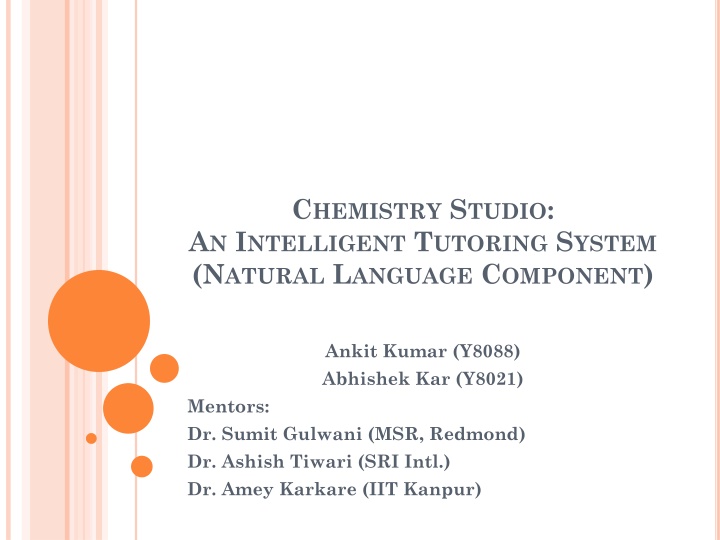
Intelligent Chemistry Tutoring System with Natural Language Component
"Explore Chemistry Studio, an intelligent tutoring system focusing on the Periodic Table domain. It emulates student reasoning processes, generates hints, and solves problems. Discover the two main components, Natural Language and Problem Solving, along with an intermediate logical representation used to encapsulate facts. Dive into the details of the lexer, option parsing, and cues identification algorithms for efficient problem-solving."
Uploaded on | 3 Views
Download Presentation

Please find below an Image/Link to download the presentation.
The content on the website is provided AS IS for your information and personal use only. It may not be sold, licensed, or shared on other websites without obtaining consent from the author. If you encounter any issues during the download, it is possible that the publisher has removed the file from their server.
You are allowed to download the files provided on this website for personal or commercial use, subject to the condition that they are used lawfully. All files are the property of their respective owners.
The content on the website is provided AS IS for your information and personal use only. It may not be sold, licensed, or shared on other websites without obtaining consent from the author.
E N D
Presentation Transcript
CHEMISTRY STUDIO: AN INTELLIGENT TUTORING SYSTEM (NATURAL LANGUAGE COMPONENT) Ankit Kumar (Y8088) Abhishek Kar (Y8021) Mentors: Dr. Sumit Gulwani (MSR, Redmond) Dr. Ashish Tiwari (SRI Intl.) Dr. Amey Karkare (IIT Kanpur)
INTRODUCTION Aim to build an intelligent tutoring system targeted at the domain of Periodic Table (Chemistry) Targeted at solving problems by emulating thought processes/lines of reasoning employed by students Much more than a problem solver aid learning by generating hints and intelligent problems
SYSTEM OVERVIEW System divided into two components Natural Language Component Translate natural language input to an intermediate logical representation Paraphrasing of hints and problems generated Problem Solving Component Solve problems, generate hints and new problems of graded difficulty More info: Problem Solving team
INTERMEDIATE LOGICAL REPRESENTATION Formulated an intermediate representation to encapsulate facts and trends in the Periodic Table Formula interpreted as the value of the free variable(s) that make(s) it true ????? ?? ????(????? ?? ,$1) Terms in logic Predicates, Functions and Simple terms Input & Output types assigned to terms (Forms the crux of our algorithm)
NATURAL LANGUAGE COMPONENT Input Problem Lexer Option Parsing Terms in logic Parser Tier 1 Domain information Full logical representation Parser Tier 2 Tokens
LEXER Try to identify cue phrases in the sentence that hint at occurrence of terms in its logical representation Cue Phrases Ionisation Energy Greatest Actinide Logic Terms IE() Max() RareEarthElement() Matching robust to appearance of derivatives of cues by using a Levenshtein distance based similarity score. ????? ?1,?2 = 1 ?? ?1,?2/???(?1.???,?2.???) Metadata like position and match score also collected
OPTION PARSING Extract information regarding the final output of the question What is the atomic number of Na? - i)11 ii)12 iii)21 iv)26 Same(Group Al ,$1) Infer presence of implicit terms Arrange the following in increasing order of atomic radius: i)Na<Mg<Al ii)Mg<Al<Na iii)Al<Mg<Na Order(AtomicRadiusProperty,Increase,$1) Number of domain variables to insert Which of the following sets contains a metalloid? - i)Sb,Be,N ii)Al,Ar,Xe iii)Ar,Cl,Br Or(Metalloid($1), Metalloid($2), Metalloid($3))
PARSER Intermediate representation viewed as a tree whose preorder traversal generates the representation Arranges identified terms into a type-consistent representation tree Two possible approaches Bottom-up Top-down Provides better control Same Group Group $1 Li
PARSER-CONTD. Take terms identified by lexer and create tokens with holes Two types of tokens: Simple token - One non-hole node Compound token Multiple non-hole nodes Same Group Hole Same Hole Hole Hole Parser to fill these holes with other subtrees in a type safe manner such that the final tree generated has no holes. Two tiered organization
PARSER TIERI Exploits local structure of input to construct compound tokens from simple tokens Prevent construction of extraneous formulae Which element is in group 3 and period 2? And(Same(Group($1) , 3), Same(Period($1), 2)) And(Same(Period($1) , 3), Same(Group($1), 2)) Associate numbers with numeric predicates based on proximity Associate equality predicate with a numeric function based on proximity Identify certain terms which generally occur coupled with other terms
PARSER TIERII As a top down approach, algorithm is a recursive one with a decision made at every execution step Fill left most hole in every execution step and branch a decision path Implement a ranking scheme to disambiguate multiple generated trees 4 cases at every execution step no holes, but unused tokens left no holes, all tokens used holes with unused tokens holes with all tokens used
AN EXAMPLE - LEXER Which element in group 2 has the maximum metallic property? i)Be ii)Mg iii)Ca iv)Sr Which element in Group 2 has the maximum metallic character? Group 2 has the maximum metallic character? 2 has the maximum metallic character? maximum metallic character? metallic character? Group 2 Max MetallicProperty
PARSER TIER 1 Group 2 Max MetallicProperty $1 Max Same Hole Hole Metal licPro perty 2 Group Hole
PARSING TIER 2 Max $1 Same Max 2 Metal licPro perty Group Hole Hole MetallicPr operty Same Hole 2 Group $1
SPECIAL TECHNIQUES Variable Branch Which element is in the same group as Lithium and same period as Barium? And(Same(Group($1),Group(Li)),Same(Period($1),Period(Ba))) And(Same(Group(Ba),Group(Li)),Same(Period($1),Period(Ba))) Heuristic: At least one of the children subtree of every Same() node in a tree should have at variable in it. All children subtrees of every And() node in a tree should have a variable. Permutation Removal Same(Group($1),Group(Li)), Same(Group(Li),Group($1)) ??????(???????)= it s textual representation Maintain the following invariant for every internal node ?????? ???????? < ?????? ???????? ? < ?
FURTHER WORK Challenges for lexer At, In s, p Forall queries Assertion based questions Paraphrasing






















